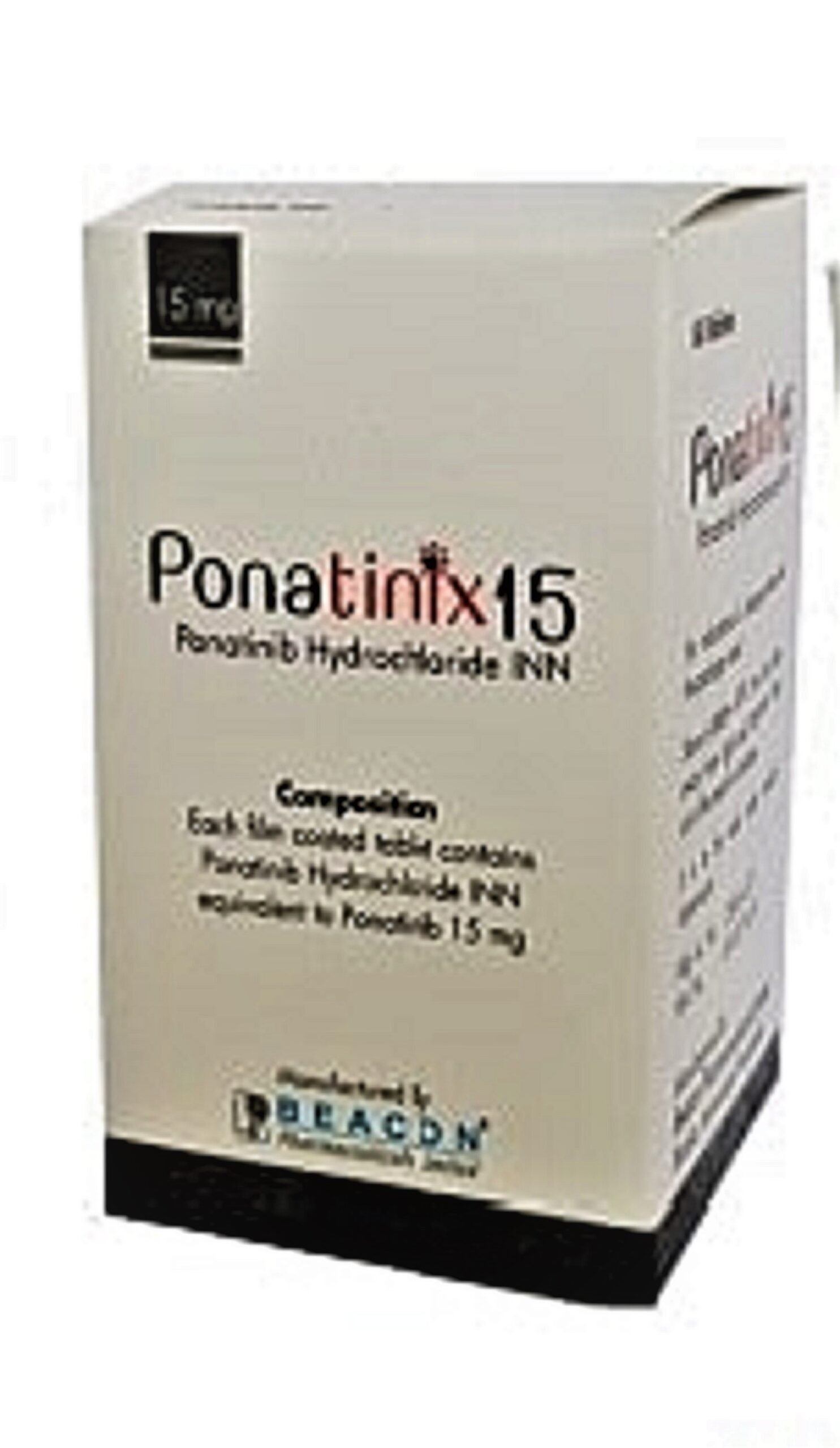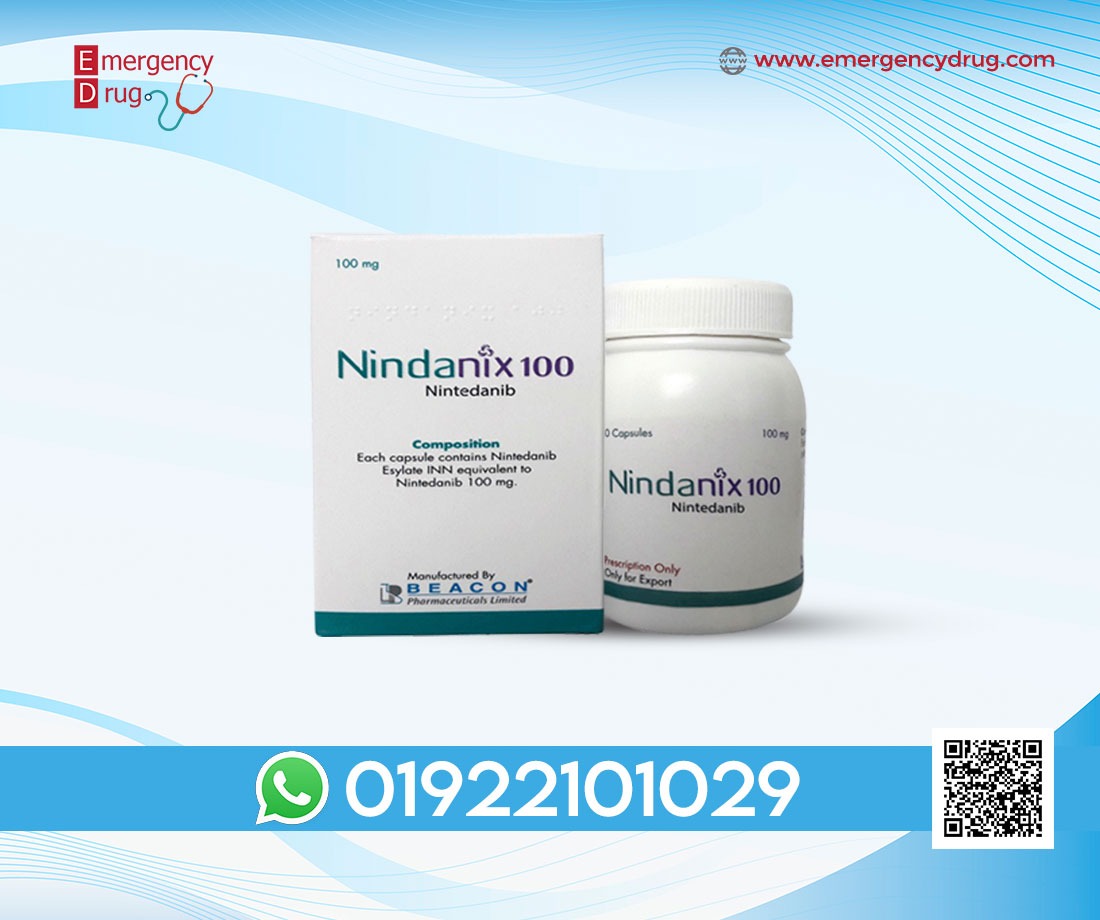
Ponatinix (Ponatinib) 15 MG
Price: $445.00
Ponatinix(Ponatinib) indicate for the treatment of patients with chronic phase, accelerated phase, or blast phase chronic myeloid leukemia (CML) that is resistant or intolerant to prior tyrosine kinase inhibitor therapy or Philadelphia chromosome positive acute lymphoblastic leukemia (Ph+ALL) that is resistant or intolerant to prior tyrosine kinase inhibitor therapy.


Description
Ponatinix (Ponatinib), generic is a prescription Tablets use to treat of blood cancer which is chronic phase, accelerated phase, or blast phase chronic myeloid leukemia (CML) or Philadelphia chromosome positive acute lymphoblastic leukemia (Ph+ ALL) for whom no other tyrosine kinase inhibitor (TKI) medicines are received. Ponatinix manufactured by Beacon Pharma Ltd. in Bangladesh.
Product Features
| Product Name | : | Ponatinix |
| Generic Name | : | Ponatinib |
| Formulation | : | Tablet |
| Available Pack Size | : | 60’s pot |
| Available Strength | : | 15 mg |
| Registrations | : | Export Only |
| Website | : | Ponatinix.com |
Indications
Ponatinib is a kinase inhibitor indicated for the:
Adult patients with chronic phase, accelerated phase, or blast phase chronic myeloid leukemia (CML) or Ph+ ALL for whom no other tyrosine kinase inhibitor (TKI) therapy is indicated.
Patients with T315I-positive CML (chronic phase, accelerated phase, or blast phase) or T315I-positive Philadelphia chromosome positive acute lymphoblastic leukemia (Ph+ ALL).
Pharmacology Ponatinib
Ponatinib inhibited the in vitro tyrosine kinase activity of ABL and T315I mutant ABL with IC 50 concentrations of 0.4 nM and 2.0 nM, respectively. In vitro, activity of additional kinases with IC 50 concentrations between 0.1 nM and 20 nM, including members of the VEGFR, PDGFR, FGFR, EPH receptors and SRC families of kinases, and KIT, RET, TIE2, and FLT3. There is viability of cells expressing native or mutant BCR-ABL, including T315I. In mice, treatment with ponatinib reduce the size of tumors expressing native or T315I mutant BCR-ABL when compared to controls.
Dosage & Administration
The optimal dose of Ponatinib has not been identified. In clinical trials, the starting dose of Ponatinib was 45 mg administered orally once daily. However, in the phase 2 trial, 68% of the patients required dose reductions to 30 mg or 15 mg once daily during the course of therapy.
Start dosing with 45 mg once daily. Consider reducing the dose of Ponatinib for patients with chronic phase (CP) CML and accelerated phase (AP) CML who have achieved a major cytogenetic response. Consider discontinuing Ponatinib if response has not occurred by months(90 days). Ponatinib may be taken with or without food.
Side Effects
The most common non-hematologic adverse reactions (≥20%) were, abdominal pain, rash, constipation, headache, dry skin, arterial occlusion, fatigue, hypertension, pyrexia, arthralgia, nausea, diarrhea, lipase increased, vomiting, myalgia and pain in extremity.
Pregnancy & Lactation
In animals, it cause fetal harm when administered to a pregnant woman. There are no available data on Ponatinib use in pregnant women. In animal reproduction studies, oral administration of ponatinib to pregnant rats during organogenesis caused adverse developmental effects. At doses lower than human exposures at the recommended human dose. Advise pregnant women of the potential risk to a fetus.
There is no data on the presence of ponatinib in human milk. The effects on the breastfed infant or on milk production.
Warnings and Precautions
Arterial occlusions, including fatal myocardial infarction, stroke, stenosis of large arterial vessels of the brain, severe peripheral vascular disease has occurred in at least 35% of Ponatinib-treated patients from the phase 1 and phase 2 trials. With a minimum of 48 months follow-up for ongoing patients (N=133) in the phase 2 trial, 33% (150/449) of Ponatinib treated patients experienced a cardiac vascular (21%), peripheral vascular (12%), or cerebrovascular (9%) arterial occlusive event; some patients experienced more than 1 type of arterial occlusive event.
Ponatinib can cause fatal and life-threatening arterial occlusion within 2 weeks of starting treatment, and at dose levels as low as 15 mg per day. Ponatinib can also cause recurrent or multi-site vascular occlusion. Patients have required revascularization procedures (coronary, cerebrovascular, and peripheral arterial).
Venous thromboembolic events occurred in 6% (25/449) of Ponatinib-treated patients, including deep venous thrombosis (10 patients), pulmonary embolism (7 patients), superficial thrombophlebitis (3 patients), and retinal vein thrombosis (2 patients) with vision loss.
In the phase 2 trial, the incidence of venous thromboembolism was 9% (3/32) in patients with Ph+ ALL, 10% (6/62) in patients with blast phase (BP) CML, 4% (3/85) in patients with AP-CML, and 5% (13/270) in patients with CP-CML. Consider dose modification or discontinuation of Ponatinib in patients who develop serious venous thromboembolism.
Fatal or serious heart failure or left ventricular dysfunction occurred in 6% of Ponatinib-treated patients (N=29/449) in the phase 2 trial (48 months follow-up). Nine percent of patients (N=39) experienced any grade of heart failure or left ventricular dysfunction. The most frequently reported heart failure events were congestive cardiac failure and decreased ejection fraction (in 14 patients each; 3%).
Monitor patients for signs or symptoms consistent with heart failure and treat as clinically indicated, including interruption of Ponatinib. Consider discontinuation of Ponatinib in patients who develop serious heart failure?
Arrhythmias occurred in 19% (86/449) of Ponatinib-treated patients, of which 7% (33/449) were grade 3 or greater. Arrhythmia of ventricular origin was reported in 3% (3/86) of all arrhythmias, with one case being grade 3 or greater. Symptomatic bradyarrhythmia’s that led to pacemaker implantation occurred in 1% (3/449) of Ponatinib-treated patients. Atrial fibrillation was the most common arrhythmia and occurred in 7% (31/449) of patients, approximately half of which were grade 3 or 4.
Other grade 3 or 4 arrhythmia events included syncope (9 patients; 2.0%), tachycardia and bradycardia (2 patients each 0.4%), and electrocardiogram QT prolonged, atrial flutter, supraventricular tachycardia, ventricular tachycardia, atrial tachycardia, atrioventricular block complete, cardio-respiratory arrest, loss of consciousness, and sinus node dysfunction (1 patient each 0.2%). For 27 patients, the event led to hospitalization. In patients with signs and symptoms suggestive of slow heart rate (fainting, dizziness) or rapid heart rate (chest pain, palpitations or dizziness), interrupt Ponatinib and evaluate.









